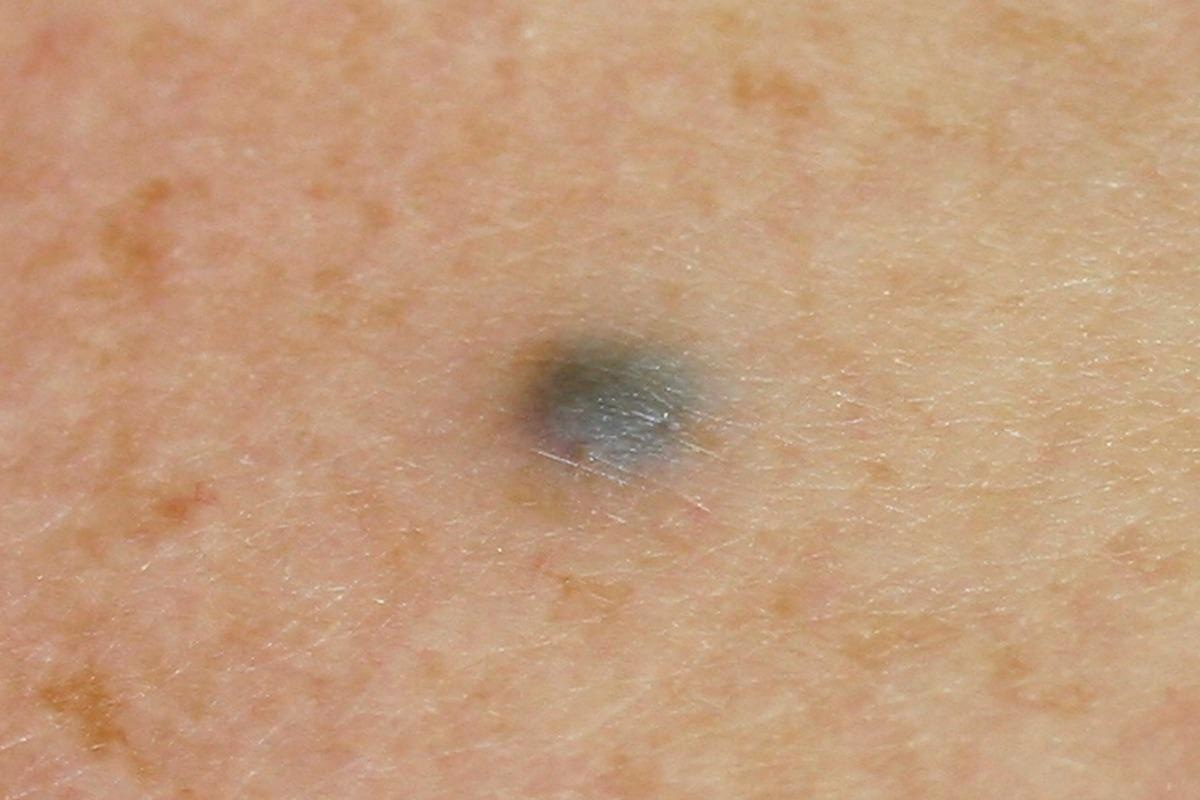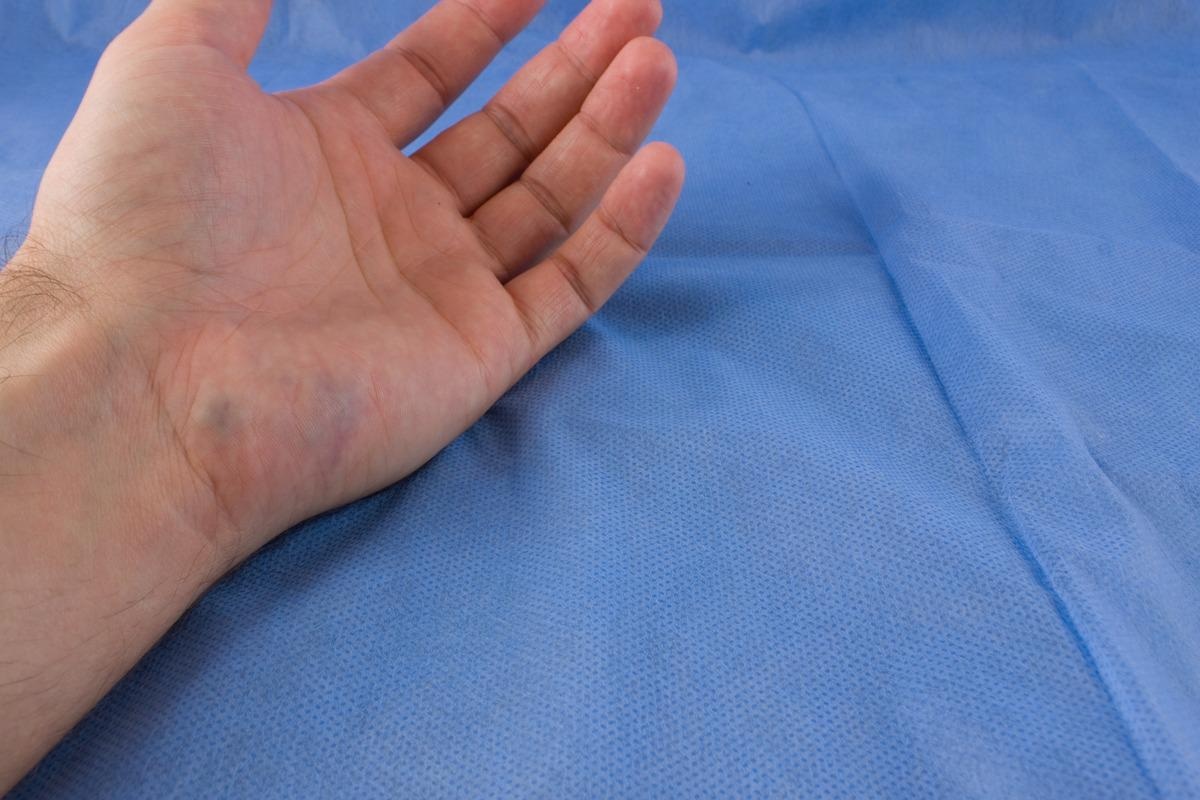Blue Rubber Bleb Nevus Syndrome (BRBNS), also known as bean syndrome, is an extremely rare and severe condition. It has a heterogeneous spectrum of clinical features involving multiple venous malformations of the skin and internal organs (liver, heart, spleen). It is a congenital vascular disease with various phenotypic patterns.
BRBNS is most common in childhood and adolescence, with only a few cases occurring in adults. The risk of gastrointestinal hemorrhage and severe iron deficiency anemia is higher in patients with blue rubber bleb nevus syndrome. Treatment is mostly supportive, with some risk management thrown in for good measure.

Image Credit: Dermatology11/Shutterstock
Causes and symptoms
The etiopathology of BRBNS is unknown at this time. BRBNS is a rare condition characterized by somatic double (cis) mutations in the TEK gene that produce ligand-independent receptor hyperphosphorylation in vitro, according to a study published by Soblet and colleagues. However, autosomal dominant inheritance has been documented.
BRBNS can have a variety of clinical symptoms depending on the organs involved. Multiple venous malformations in numerous organ systems, including the eye, heart, liver, spleen, and central nervous system, are seen in patients. The cutaneous and gastrointestinal systems are frequently involved in the lesions. Other organs, such as the central nervous system, liver, and muscles, may also be involved. Gastrointestinal bleeding and subsequent iron deficiency anemia are the most common symptoms. Severe consequences, including rupture, intestinal torsion, and intussusception, can occur, and the condition may potentially result in death. The majority of cutaneous abnormalities are asymptomatic and do not require treatment.
Multiple blue to violaceous soft compressible nodules on the mucous membranes or skin are seen in patients with blue rubber bleb syndrome. They are frequently born with a "dominant" lesion and go on to develop many venous abnormalities throughout their lives. When crushed, the usual skin lesions are described as having a rubbery nature and being unpleasant or tender. The pain is very bad at night. These lesions can be as small as a few millimeters in diameter or as large as 4 to 5 centimeters in diameter. They can grow over time, and new lesions in the skin or gastrointestinal system may appear.
It's also possible that big, disfiguring blue marks will form. Lesions enlarge in gravity-dependent positions, and patients exhibit hyperhidrosis in specific areas underlying these lesions.
The heart, liver, spleen, central nervous system, and gastrointestinal tract can all have venous malformations. The small bowel is the most prevalent site of gastrointestinal tract involvement. However, lesions can occur anywhere along the gastrointestinal tract, from the mouth to the anus. As a result of the repeated gastrointestinal hemorrhage, individuals may develop severe iron deficiency anemia. The retina, conjunctiva, iris, and orbit may develop angiomas and venous malformations. Thyroid, musculoskeletal, lung, parotid, and bladder involvement have also been reported.
The TEK gene
The TEK gene produces the TEK receptor tyrosine kinase protein. The TEK receptor tyrosine kinase is a transmembrane receptor that plays a role in angiogenesis, including instability of existing arteries, endothelial cell migration, tube creation, and mesenchymal cell stabilization of newly created tubes. When the TEK receptor is activated, chemical signals are released, allowing endothelial cells and smooth muscle cells to communicate with one another. This interaction promotes the development of new blood vessels while also preserving their structure and integrity. Due to somatic activating mutations, the TEK receptor is constitutively active in blue rubber bleb nevus syndrome. This results in uncontrolled angiogenesis.
Epidemiology
Blue rubber bleb nevus syndrome is a rather uncommon condition. In the literature, there have been about 200 cases recorded. It has been found in people of all ethnicities, with White populations being the most affected. The cutaneous signs of the disease often appear at birth or early infancy, and it affects both males and females equally. Early adulthood is when visceral involvement usually appears.

Image Credit: Topolszczak/Shutterstock
Diagnosis and management
Diagnostic methods include imaging tests in addition to clinical diagnosis. Because it is the least invasive, ultrasound is the first diagnostic test of choice. If gastrointestinal venous abnormalities are suspected, an endoscopic ultrasound may be performed. If ultrasound is inconclusive or impossible, MRI with intravenous contrast, arterial and venous phases, and fat suppression is recommended. Computed tomography (CT), barium tests, and skin biopsy are some of the other diagnostic options. Fecal occult blood tests, complete blood counts, and urinalysis to screen for hematuria and bladder involvement are some other laboratory procedures that may be useful in the evaluation and management of patients.
Blue rubber bleb nevus syndrome is mostly treated symptomatically. The most crucial step is to keep an eye on the progression of gastrointestinal lesions and avoid major bleeding. The severity of the disease and the amount of intestinal involvement influence the therapy of gastrointestinal lesions.
Supportive care, such as iron supplementation and blood transfusions, is effective for the majority of patients. Surgical excision, endoscopic sclerosis, and laser photocoagulation have all been suggested for more serious hemorrhages or consequences.
According to a recent study, endoscopic submucosal dissection (ESD) is a viable method for removing partial GI lesions. Another study looked at how BRBNS reacted to sirolimus. They discovered that sirolimus is a safe and effective treatment for BRBNS, even when other treatments have failed. In this trial, all four patients had a long-term response to sirolimus treatment with few side effects. More prospective trials are needed to assess the drug's long-term effects in this patient population and its application in frontline settings.
A wide range of treatment methods has been presented, including medicinal therapy, endoscopic intervention, and surgical excision. Sufficient evidence, long-term prospective data, and newly available medicines, on the other hand, will need to be found in the future.
References:
- Marakhouski, K., Sharafanovich, E., Kolbik, U., Sautin, A., Nikalayeva, K., Pataleta, A., ... & Svirsky, A. (2021). Endoscopic treatment of blue rubber bleb nevus syndrome in a 4-year-old girl with long-term follow-up: A case report. World Journal of Gastrointestinal Endoscopy, 13(3), 90–96. https://doi.org/10.4253/wjge.v13.i3.90
- Baigrie, D., Rice, AS., & An, IC. (2020). Blue Rubber Bleb Nevus Syndrome. In: StatPearls. StatPearls Publishing, Treasure Island (FL). PMID: 31082129.
- Isoldi, S., Belsha, D., Yeop, I., Uc, A., Zevit, N., Mamula, P., ... & Thomson, M. (2019). Diagnosis and management of children with blue rubber bleb nevus syndrome: a multi-center case series. Digestive and Liver Disease, 51(11), 1537-1546. https://doi.org/10.1016/j.dld.2019.04.020
- Chen, W., Chen, H., Shan, G., Yang, M., Hu, F., Li, Q., Chen, L., & Xu, G. (2017). Blue rubber bleb nevus syndrome: our experience and new endoscopic management. Medicine, 96(33), e7792. https://doi.org/10.1097/MD.0000000000007792
- Salloum, R., Fox, C. E., Alvarez‐Allende, C. R., Hammill, A. M., Dasgupta, R., Dickie, B. H., ... & Adams, D. M. (2016). Response of blue rubber bleb nevus syndrome to sirolimus treatment. Pediatric blood & cancer, 63(11), 1911-1914. https://doi.org/10.1002/pbc.26049
- Jin, X. L., Wang, Z. H., Xiao, X. B., Huang, L. S., & Zhao, X. Y. (2014). Blue rubber bleb nevus syndrome: a case report and literature review. World journal of gastroenterology, 20(45), 17254–17259. https://doi.org/10.3748/wjg.v20.i45.17254
- Agnese, M., Cipolletta, L., Bianco, M. A., Quitadamo, P., Miele, E., & Staiano, A. (2010). Blue rubber bleb nevus syndrome. Acta paediatrica (Oslo, Norway: 1992), 99(4), 632–635. https://doi.org/10.1111/j.1651-2227.2009.01608.x
Further Reading